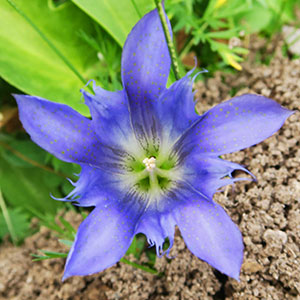Gentiana newberryi
Gentiana linearis
alpine gentian, Newberry's gentian
gentiane à feuilles linéaires, narrow-leaf gentian
1–5, arising laterally below rosettes, from a stout tap root, tufted, decumbent.
1–30, terminal from caudex, erect.
basal and cauline;
blades of basal rosette and proximal cauline leaf blades widely spatulate to obovate or oblanceolate, 0.8–5 cm × 2–25 mm, apex obtuse or mucronate, at least these leaves with blades less than 6 times as long as wide, distal cauline leaves few, with blades oblanceolate to lanceolate or linear, 2–5 cm × 2–5 mm, apices acute.
cauline, nearly evenly spaced or somewhat more widely spaced distally;
blade linear to lanceolate, 4–9 cm × 3–14 mm, apex acute.
terminal, flowers usually solitary, occasionally 2 or 3.
± dense 1–7-flowered cymes, sometimes with additional flowers at 1–4 nodes, sessile or on branches to 12 cm.
calyx 14–30 mm, lobes linear to narrowly ovate, (4–)6–12 mm, margins not ciliate;
corolla white or blue, campanulate, open, 23–55 mm, lobes spreading, elliptic-obovate, 7–17 mm, free portions of plicae divided into 2 triangular, serrate to lacerate segments;
anthers distinct.
calyx 8–28 mm, lobes linear to oblong, 2–12(–15) mm, margins not ciliate;
corolla blue or occasionally violet or white, tubular, loosely closed or slightly open, 25–50 mm, lobes ± incurved, semicircular, 2.5–5 mm, free portions of plicae obliquely triangular, margins entire or shallowly erose, with a minute, deflexed second segment;
anthers connate.
winged.
winged.
= 26.
Gentiana newberryi
Gentiana linearis
Varieties 2 (2 in the flora).
The two varieties of Gentiana newberryi intergrade extensively. The most distinctive form of var. newberryi, with relatively tall stems and medium to deep blue corollas, occurs in the northern part of the range of the species, from the Klamath and White mountains of California north into Oregon. Plants most clearly referable to var. tiogana prevail in the southern part of the range of the species, from Butte County south to Inyo and Tulare counties, California. In the central part of the range of the species, plant size and corolla color are less consistently correlated, with occasional plants combining low stature with deep blue corollas or tall stems with predominantly white or pale blue corollas. In that part of the range, corolla color may be highly variable within a single population.
The leaves of Gentiana newberryi are thick-textured and distinctively concave, usually spoon-shaped, when fresh. Narrower leaves sometimes occur in var. tiogana, but many plants of that variety have widely spatulate leaves like those of var. newberryi.
(Discussion copyrighted by Flora of North America; reprinted with permission.)
Gentiana linearis is extirpated from New Jersey. Reports from Manitoba and Minnesota have been based on circumscriptions of G. linearis that included G. rubricaulis, mostly prior to the recognition of G. rubricaulis as a distinct species in standard floras. A report from North Carolina is incorrect, having been based on a misunderstanding as to where a photograph was taken (W. F. Hutson, pers. comm.). Narrow-leaved specimens of G. saponaria are occasionally misidentified as G. linearis but can be distinguished by their ciliate calyx lobes and by the shape of the calyx lobes and the free portions of the corolla plicae.
(Discussion copyrighted by Flora of North America; reprinted with permission.)
1. Corollas medium to deep blue with greenish to dark purple lines abaxially on and below lobes, usually 35–55 mm. | var. newberryi |
1. Corollas white to pale blue except for greenish to dark purple lines abaxially on and below lobes, usually 23–42 mm. | var. tiogana |


